
Miklós Rózsa (1907-1995)
Sinfonia Concertante for Violin, Cello and Orchestra Op.29 (1966)
Rhapsody for cello and orchestra Op.3 (1929)
Notturno ungherese Op.28 (1964)
Harriet Krijgh (cello), Nikita Boriso-Glebsky (violin)
Deutsche Staatsphilharmonie Rheinland-Pfalz/Gregor Bühl
rec. 2024, Philharmonie, Ludwigshafen, Germany
Capriccio C5535 [57]
Miklós Rózsa titled his autobiography A Double Life: he felt he had two careers, one in Hollywood and one in the concert hall. (That was also the title of a 1947 film for which he wrote the score.) Here we have three of his best-known concert works. Conductor Gregor Bühl shows himself to be a master with Rozsa’s music.
The early Rhapsody for Cello and Orchestra is important for its inherent musical value – and because it was the work in which Rózsa felt he “more or less found his style”, to quote from the notes by MWI contributor Jens F. Laurson. As Laurson points out, the solo passages are the most interesting, but the whole piece is compelling and dramatic. While the Rhapsody is a little reminiscent of Bartók and Kodály, it also announces Rózsa as a new talent on the Hungarian musical scene.
The Notturno ungherese dates from Rózsa’s full maturity. It is one of many pieces for orchestra commissioned by the New Orleans businessman Edward B. Benjamin for his Tranquil Music Project. Benjamin’s brief to composers for the Project was to compose a piece that one could listen to, especially if one was a harried businessman, to restore one’s sense of calm. Rózsa’s contribution was an eight-minute essay in nostalgia for his Hungarian childhood. The Notturno is very beautiful. The nostalgia is kept under control, and there is a slight American feel to some of the writing.
Rózsa was friendly with many great musicians, including cellist Gregor Piatigorsky and violinist Jascha Heifetz. For the latter, he had written his well-known Violin Concerto from 1953. About ten years later, Piatigorsky requested a concerto-like piece for the two musicians. The result was one of Rózsa’s best works, the Sinfonia Concertante for Violin, Cello, and Orchestra. It had a difficult gestation: Heifetz objected to the prominent role given to the cello, but eventually he grew to love the work.
The piece begins forcefully, somewhat belying its tempo marking of adagio non troppo lento. While the music for the soloists is as virtuosic as one would expect, the prevailing mood is slightly apprehensive. The high point of the movement is a cadenza for the two soloists, some of the composer’s finest writing. The Theme and Variations (andante) is the movement that Heifetz originally objected to, but in the final version the cello is featured as Rózsa originally intended. The variations show great invention; the last two are especially lovely. The final allegro con brio features very imaginative writing for the two soloists, especially for the cellist.
Simply put, the performances here are excellent. Nikita Boriso-Glebsky and Harriet Krijgh’s playing combines effortlessly. Both are undaunted by the demands made on them by Rózsa’s score. Krijgh’s playing is also notable for its air of refinement and depth of feeling, especially in the Rhapsody. Bühl has already recorded a disc of three other Rózsa orchestral works for Capriccio (review). One hopes that he will continue with the rest of the orchestral music.
A fine disc all round.
William Kreindler
Buying this recording via a link below generates revenue for MWI, which helps the site remain free




















